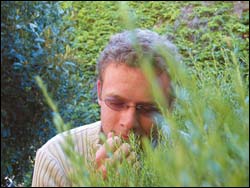Indigenous crops to foster social development
29 November 2004
Sweet fragrance: Master's student Graham Rowe's seminar examined commercial and human development opportunities in indigenous plants. This Cape May or Confetti Bush (Coleonema album) is used by fishermen to remove the smell of redbait from their hands, and campers use it to repel mosquitoes and other insects. An extremely fragrant essential oil derived from the plant is also produced on a small scale.
Kicking off with the inaugural seminar in a prestigious series is like being asked to perform first at an eisteddfod. For better or worse, you set the pace.
Master's student and Potter Fellow Graham Rowe will be more than pleased that his efforts have been lauded by the participants, including some top-flight, rated scientists and some bigwigs from business. The geneticist cum botanist was first up in the new David and Elaine Potter Charitable Trust seminar programme, presenting a packed itinerary that looked at growing the commercial potential of indigenous plant biodiversity through new partnerships between science, business and civil society.
Used throughout the centuries, indigenous plants offer more than medicinal or health properties; they also mean big money, a means of establishing niche markets, the spin-offs of which can be ploughed into those communities involved in their cultivation and harvesting.
Take rooibos tea. The industry is worth R150-million a year. The humble Buchu (Agathosma ovata), industry nets around R100-million a year and the honeybush (Cyclopia) trade is burgeoning.
"Generally, these industries developed following the passion of individuals, Rowe says. "But there is no structure in place to encourage the development of similar indigenous products."
And there are many that could be developed. Commercially available Buchu, for example, is but one of about 300 closely-related indigenous fragrant species in the family Rutaceaea. Most of these remain unexplored.
"There may be many that could find their way to the market."
One of the seminar participants, Ben-Erik van Wyk, has worked on a wide variety of useful South African plants. He pointed out that although Cape plants have thus far made a modest contribution to the multi-billion dollar pool of global medicinal and neutraceutical products, there are a number of promising candidates at various stages of development.
"The cancer bush, Sutherlandia frutescens, has been used by South Africans for generations to treat a wide variety of diseases. It is now widely marketed as a health tonic and there has been a flurry of scientific activity around its potent immune-boosting properties." Other intriguing plants include Aloe ferox, Bulibine, Dicoma, Devil's Claw, Leonotus and Sceletium. The fascinating properties of these plants have made them all the subject of scientific investigation and product development.
Essential oils is another blooming area, representing a multi-billion dollar industry. These oils are extracted from plants for perfuming or flavouring consumer products, or for their health benefits.
"We have over 1 000 potential candidate plants in South Africa," Rowe comments.
The Wits pharmacology and pharmacy departments have a programme to record the essential oil composition of indigenous plants. Over 100 plants have already been tested and their biological activities (antimicrobial, anti-inflammatory and antioxidant) recorded. Here are further commercial opportunities. Natural templates could also be modified to produce more potent active substances, translating into viable commercial products.
However, the drive to produce more products should be matched by a parallel development: regulation and quality control. Pietersarel de Bruyn, managing director of Herbs Aplenty, says the world trend towards healthy living and natural products has created conflicting scenarios for the producers of essential oils.
"Some manufacturers simulate the natural ingredients while on the other hand legislation forces the industry to be responsible to the consumer in terms of potential health risks, as essential oils are made up of numerous chemical compounds."
But the seminar discussions always reverted to the people factor - how to foster civil society - the aim of the series. Participants switched the discussion to job creation, the management of indigenous resources, and the protection of intellectual property.
Rowe believes a body like the South African National Biodiversity Institute, with a recent government mandate to oversee the sustainable use of the country's natural resources, could be a natural manager of the process to exploit the potential of indigenous plants, an umbrella organisation for players in the field. There is, however, the small but unanswered question of funding any formalisation of these endeavours.
The most exciting component of the day was the discussion session in which the group explored how best to create a nurturing environment for new crop development. This complex business requires that researchers, marketers, entrepreneurs, growers and government work in sync. Greater cooperation will ensure that the economic potential of the country's magnificent plant biodiversity is unleashed for the benefit of all South Africans.
Adjusting institutional arrangements, lobbying for legislative changes and, most importantly, a more fluid exchange of skills and knowledge, were identified as key tasks that would have to be tackled.
Whether this will take place within existing institutions or whether a new organisation will have to be developed specifically to drive these processes is the subject of ongoing debate.
Rowe's seminar is sure to have planted its own seeds.
 This work is licensed under a Creative Commons Attribution-NoDerivatives 4.0 International License.
This work is licensed under a Creative Commons Attribution-NoDerivatives 4.0 International License.
Please view the republishing articles page for more information.










